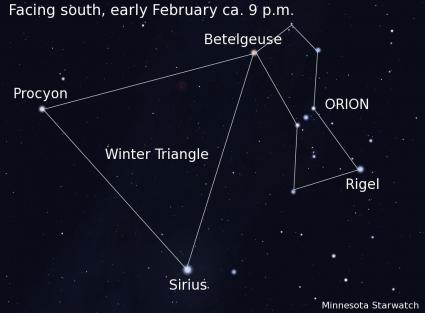Northern Sky: February 16, 2019
NORTHERN SKY – Deane Morrison
February 16 – March 1, 2019
In the second half of February, most of the astronomical action is still in the morning sky.
Venus is heading toward the sunrise while Saturn is climbing up away from it. Between the 17th and the 19th, the two planets pass each other. They come closest on the 18th, when Saturn will be one degree, or two moon widths, below Venus, which is by far the brighter planet. For the rest of the month, the distance between them widens, and by March 1 they’ll be 10 degrees apart.
Saturn is following Jupiter, and now these two outer planets are rising earlier every day as they sail westward across the morning sky. Jupiter is brighter than Saturn, but in case you’re not sure which object is which, a fat crescent moon will be right above Jupiter on February 27th. A thinner crescent will be near Saturn on March 1, and Venus on March 2.
What makes the outer planets move westward across the sky—and the stars, too—is Earth’s orbital motion. But the outer planets’ own orbital motion makes them drift eastward with respect to the background of stars. Jupiter drifts eastward faster than Saturn, and now, that motion is carrying it toward Saturn. Late next year, Jupiter will pass Saturn—and very closely, which will be a lot of fun to watch.
In the evening sky, Mars is still in the west after nightfall. It’s the vlodrdy of the outer planets, and moves the most rapidly eastward against the stars. It is dropping westward, but so slowly that it seems to be holding its own as the stars rush past it. Right now, that’s what the group of bright winter constellations is getting ready to do.
One of those constellations is Gemini, the twins. Its two brightest stars are Castor and Pollux, the heads of the twins. Gemini’s other stars are dimmer, but still, this constellation looks like what it’s supposed to be: two human figures. Pollux is lower and slightly brighter than Castor. Pollux is a large star with at least one large exoplanet, but Castor, not to be outdone, is a system of six stars. It has two main stars that orbit each other.
Each is a little bigger than the sun, and each has a small companion called a red dwarf star. And associated with this system is a pair of red dwarf stars that orbit each other and also appear to orbit the two main stars, albeit very slowly. Multistar systems are common, and needless to say, they can get complicated.
On the 16th, a bright waxing moon will be near the Gemini twins. Two nights later it’ll be near the backward question mark of stars that outlines the head of Leo, the lion. Early the next morning, at 3:03 a.m. on February 19th, the moon reaches perigee, its closest approach to Earth in this lunar cycle. Not quite seven hours later, it becomes full. Because it will be so close to us, this full moon qualifies as another supermoon, so it’ll be especially large and bright.
There’s just one little fly in the ointment, a common one when full moons come in the morning. On that day, the 19th, the moon sets over Grand Marais at 7:18 a.m.—a couple of hours before fullness. So if you want to see a supermoon at its biggest, roundest and brightest, go outside at least half an hour before moonset, which would mean by 6:45 a.m. And you’ll need a clear view of the western horizon. Or, if you’d rather watch a super moonrise, try the one right after full moon, on the evening of the 19th. It will still be pretty big and beautiful.
Tweet




